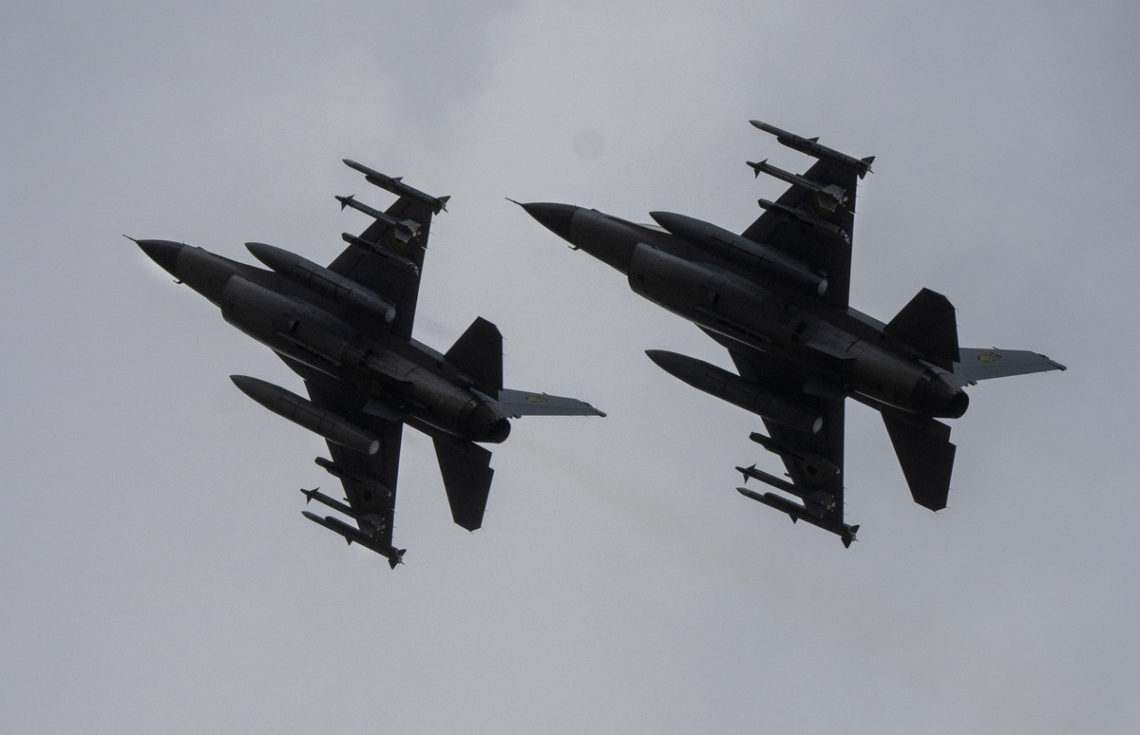Ukraine’s air force on Sunday confirmed that a third Ukrainian F-16 fighter pilot had been killed in action, a unwelcome blow for a military with a limited number of fourth-generation Western jets and a small pool of pilots trained to fly them.
Lieutenant Colonel Maksym Ustimenko intercepted seven incoming Russian air targets in his F-16 jet before his aircraft was damaged and started to lose altitude, Ukraine’s air force said in a statement on Sunday.
He is the third known F-16 pilot to be killed while operating the U.S.-made aircraft, which Ukraine has been using for little under a year.
Kyiv had long clamored for donations of the Lockheed Martin-manufactured F-16s to boost its Soviet-era aircraft while staring down Russia’s more advanced — and much more numerous — fleet that has taken far fewer hits in the war than Moscow’s land forces.
But Kyiv has not yet received all of the aircraft promised to its military, and fully-trained pilots are in short supply, despite intensive rounds of training abroad.
“With such intense fighting, losses are to be expected,” an official with Ukraine’s air force, Colonel Yuriy Ignat, said during an interview with the country’s Ukrainska Pravda outlet, published in early June.
Losing aircraft is “always part of air warfare, and while individual cases should never be decisive, attrition hurts,” said Frederik Mertens, a strategic analyst with Dutch think tank, TNO. Losing pilots is also a painful prospect, he told Newsweek.
In late August, just weeks after Kyiv confirmed it was operating the first of its donated jets, Ukraine said Oleksiy Mes — a famed pilot also known by his call sign, Moonfish — had died while “repelling a massive Russian combined air and missile attack.”
A second F-16 was shot down over the northeastern Sumy region in mid-April this year, killing its 26-year-old pilot, Pavlo Ivanov.
The following month, the air force said it had lost communication with an F-16 intercepting Russian attacks, but that the pilot had managed to eject from the aircraft. Search and rescue teams quickly located and evacuated the pilot, the military said.
Ukrainian President Volodymyr Zelensky said on Sunday he had ordered a full investigation into Ustimenko’s death. Ustimenko “mastered four types of aircraft, and his record includes truly significant achievements for Ukraine,” the Ukrainian leader said in his evening address.
All three Ukrainian F-16 pilots killed while operating the jets were posthumously made Heroes of Ukraine, the country’s highest honor.
Kyiv’s military reported in the early hours of Sunday that Russia had launched hundreds of drones and decoys at the country overnight, as well as various different types of missiles. Ignat told Newsweek it was the highest number of aerial threats recorded since the start of the full-scale war in February 2022.
Russia’s Defense Ministry said in a statement it had launched a “massive strike with high-precision long-range air, sea and land-based weapons,” including Kinzhal missiles, targeting Ukraine’s military industry and the country’s oil refineries. Andriy Yermak, Zelensky’s chief of staff, said Moscow had “struck energy facilities, infrastructure, and residential areas.”
Ukraine has repeatedly used its F-16 fighter jets, as well French-made Mirage 2000 aircraft Kyiv received in early 2025, to intercept Russian attacks on the country.
“This loss and earlier losses clearly point at the dangers of intercepting low-flying targets at close range with low-flying aircraft,” Mertens said, adding the drive to “do the utmost and take serious risks” when in the air can be especially strong when trying to shield civilians and residential buildings.
It’s not clear exactly how many of the approximately 85 F-16s committed by Denmark, the Netherlands, Norway and Belgium are now being used by Ukraine.
Rustem Umerov, Ukraine’s defense minister, said in February that Denmark had “already delivered most of the promised F-16s, with the remaining ones to arrive soon.” Umerov’s Danish counterpart, Troels Lund Poulsen, said shortly after that Copenhagen had transferred 12 out of the 19 jets it had promised Ukraine.
It’s not immediately apparent whether the remaining seven jets have been delivered. Newsweek has reached out to the Danish Defense Ministry for comment via email.
The Dutch defense ministry said in late May that the last of its 24 pledged F-16s had left the country, bound for Ukraine.
Norwegian Defense Minister Tore Sandvik told the country’s state-run NRK broadcaster in mid-May that Oslo would finish transferring F-16s to Ukraine by the end of 2025, but refused to confirm how many jets had already been donated.
Norway has officially confirmed it will send six F-16s by the end of 2025. Newsweek has contacted the Norwegian Defense Ministry for comment via email.
Then-Belgian Foreign Minister Hadja Lahbib told domestic broadcaster RTL in May 2024 that Belgium would deliver 30 F-16s to Ukraine by 2028. Belgian Prime Minister Bart De Wever said in March this year that the F-16 transfers to Ukraine were on hold until 2026, a delay blamed on hiccups to the delivery of Brussels’ replacement F-35 fifth-generation jets. Standing next to Zelensky during a press conference in April in the Ukrainian capital, the Belgian prime minister said Brussels would send two F-16s for spare parts in 2025 and two more aircraft the following year.
Belgium’s current defense minister, Theo Francken, said in May Brussels “would try to deliver the aircraft even earlier,” according to remarks reported by the Radio Free Europe/Radio Liberty outlet. The Belgian Defense Ministry has been approached for comment.
The post What F-16 Loss Means For Ukraine’s Air Power appeared first on Newsweek.




